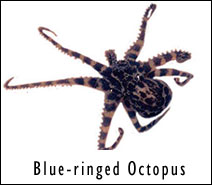Blue Ring Octopus

Common Name: Blue Ring Octopus
Scientific Name: Hapalochlaena Spp
Description
Species of Blue-ringed octopus (Hapalochlaena spp.) are common in marine waters around Australia. The common species in Moreton Bay, South-east Queensland, is Hapalochlaena fasciata. Another closely allied species with blue rings, Hapalochlaena lunulata, is confined to the tropical waters of northern and western Australia. A third species, Hapalochlaena maculosa, is found in southern Australian waters. All species are very dangerous and, as a result of bites, there have been at least two fatalities and several near fatalities.
Diet
When hunting crabs, the octopus swims over its prey and sprays poisonous saliva into the surrounding water. The victim absorbs the venom and is paralysed in minutes. Alternatively, prey may be captured with the tentacles (which bear long rows of suckers) and paralysed by a venomous bite. Prey is usually torn apart before being eaten.
Behaviour
This species is small and rarely exceeds 150 mm across its outspread tentacles. Most individuals are a mottled yellowish-brown with dark brown bands and irregular faint blue circles scattered over the tentacles and blue lines on the mantle. For this reason H. fasciata is often called the Blue-lined Octopus. When an individual is disturbed these colours darken and the rings become a vivid peacock blue.
Habitat
Typical habitats are under rocks, in crevices and in rock pools of sheltered inshore areas. The blue-ringed octopuses range from the Sea of Japan down to the waters of southern Australia; across from the Philippines to Vanuatu. They inhabit depths from intertidal flats down to 50m. They tend to hide in crevices or under rocks during the day, and emerge at night.
Life History
One of the limbs of the male octopus, usually the third right arm, is modified for the purpose of mating. This arm has a groove embedded into it and the end is shaped like a spoon. During mating, males insert the spoon-like structure into the oviduct of the female. They then place spermatophores (little "packets" of sperm) into the groove on this arm. These then slide down the arm and into the oviduct of the female. She does not conceive immediately, but rather keeps the sperm until she is ready to lay her eggs. The female takes care of the eggs until they hatch; females usually die once this job is complete.
The eggs of the Blue-ringed Octopus are large (7.5 x 3.0 mm), firm and capsule-like. Usually between 100 and 200 eggs are laid. The female guards the eggs at all times and occasionally removes debris from the egg mass with jets of water from her siphon. This action also aerates the eggs. No food is taken by the female during the period of egg development (about two months) and she dies shortly after the eggs hatch. The young develop for another four months before they are fully mature
Special Features or Habits
Blue-ringed Octopus are normally not aggressive and attack only when provoked. They are, however, the most venomous octopus in the world and the salivary glands of one individual may contain enough venom to paralyse ten men. The actual bite is often relatively painless and may go unnoticed. If sufficient venom has been introduced (sometimes little venom may enter the wound if the attack occurs under water), the victim will notice numbness or tingling around the face and neck within a few minutes.
Difficulty in seeing or speaking is often followed by trouble with breathing and sometimes vomiting. Weakness and lack of coordination usually progress to paralysis, which may last from four to twelve hours. If resuscitation is not given when breathing difficulty and paralysis begin, the victim will fall unconscious and die from lack of oxygen. Death can occur within thirty minutes
Location or Region Found
The Pacific angel shark is reported to occur only in the eastern Pacific Ocean from southeastern Alaska to the Gulf of California and from Ecuador to Chile. A gap in distribution separating subpopulations of S. californica occurs between the equator and 20° North latitude. The southern population was earlier reported as a separate species, S.armata.
 Deep Sea Crabs
Deep Sea Crabs